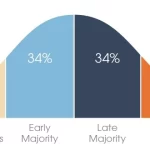How to Diagnose Your Growth Challenge
Strategy is often difficult because it’s hard to make sense out of the often-overwhelming complexity of markets. In his book Good Strategy Bad Strategy: The Difference and Why it Matters, Professor Richard P. Rumelt says there is an underlying structure to all good strategy that is comprised of three elements:
1. A diagnosis that defines or explains the nature of the challenge. A good diagnosis simplifies the often-overwhelming complexity of reality by identifying certain aspects of the situation as critical.
2. A guiding policy for dealing with the challenge
3. A set of coherent actions that are designed to carry out the guiding policy
Let’s take a look at the first element – how to diagnose/define/explain your growth challenge, and make sense of the often-overwhelming complexity of markets – and then come back to the second and third elements of good strategy next time. .
Diagnosing the Market
When trying to make decisions about Where to Play and How to Win, organizations want a solid understanding of the target customer and the firm’s relative strengths and weaknesses compared to its competitors. To achieve this understanding, if one of our clients were seeking to drive growth in a core market, we would help them diagnose the market by interviewing target customers to discover:
1. Who the target customer(s) is (confirm it)
2. What functional jobs target customers are trying to get done
3. What steps target customers must go through to successfully execute the core functional job
4. What criteria target customers use to measure success navigating through each step
5. What other related functional jobs target customers are trying to get done
6. What emotional and social jobs target customers are trying to get done, i.e., how target customers want to feel and be perceived
7. Where the opportunities for innovation and growth lie in the total market, i.e., important unsatisfied needs
8. Where the opportunities for innovation and growth lie within each jobs-based segment
9. Which segments should be avoided
10. How the firm stacks up against the competition on all the metrics that customers care about most
“OK,” you might say, “that’s a nice laundry list, but so what? What results does it deliver?”
Answer: these customer inputs provide a holistic and comprehensive set of the target customers’ needs. But, because not all customer needs are opportunities for innovation and growth, JTBD identifies those needs that are important and unsatisfied. Typically, only important unsatisfied needs are opportunities for innovation and growth. The more important and less satisfied a need is, the greater the opportunity for innovation and growth it presents. JTBD enables firms to identify the most attractive opportunities in their market with precision.
Diagnosing the Market with Statistical Validity
After uncovering all the customer needs listed above through interviews, some clients choose to deploy a quantitative survey to a representative sample of target customers as well. The purpose of the survey is to get every need statement rated for how important it is to get done and how satisfied” customers are with their ability to get it done given their current product or service solution. This enables firms to identify and rank the biggest opportunities in the market with statistical validity. It also enables firms to identify and compare opportunities in traditional segments based on demographics.
Diagnosing Market Segments
Additionally, deploying a quantitative survey makes it possible to conduct jobs-based segmentation to discovers customer segments based on how different people value getting their jobs and criteria done differently. This enables firms to find and capture hidden segments of opportunity that competitors are unlikely to even know about. A solid segmentation strategy is especially helpful in mature markets were it appears virtually all of the customers’ needs are already well-satisfied.
For example, for one client, after capturing a comprehensive set of the target customers needs, we deployed a quantitative survey to 505 target customers to have them rate each need for importance and satisfaction. The results at the total market level were not encouraging: there were zero opportunities. Not one need was both important and unsatisfied. It appeared that all of the customers’ needs were appropriately satisfied. This would have been a bummer if it were the end of the story! But results based on averages can be misleading.
When we conducted jobs-based segmentation, we discovered five unique segments with two segments of opportunity. One of the segments comprised 30% of the market and had 51 opportunities while another comprised 20% of the market and had 21 opportunities. This gave the client rich opportunities to pursue for years. Additionally, it’s highly unlikely that any of their competitors are even aware of these segments and opportunities because the competitors almost definitely have never conducted jobs-based segmentation. The “first-mover” benefits are real when you nail what customers want.
Diagnosing the Competitive Situation
Obtaining importance and satisfaction ratings on all the target customers’ needs also enables companies to sample their competitors’ customers to see how well each competitor (and the client firm) is satisfying their customers on all the metrics (jobs and criteria) that customers consider important. While most competitive analyses compare features which may or may not be correlated to customer satisfaction, a jobs-based competitive analysis identifies your firm’s strengths and weaknesses by comparing how well you and your competitors are helping customers get their important jobs and criteria done. Remember, people hired products and services to get their jobs done. These insights enable firms to create unique offerings that resonate with the targeted segments. It also can be extremely helpful for establishing your competitive position, messaging, and sales.
Do you see how JTBD “explains the nature of the challenge and identifies a few critical things to simplify the often-overwhelming complexity involved?”
Next time, we’ll look at how JTBD fulfills the last two elements of good strategy:
1. A guiding policy for dealing with the challenge
2 . A set of coherent actions that are designed to carry out the guiding policy
Is this article helpful? I love hearing from people so please don’t hesitate to reach out with questions or comments: uw@revealgrowth.com.




